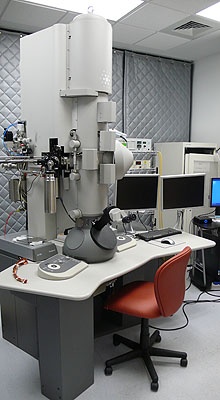The Department of Biochemistry at the University of Wisconsin–Madison is home to a large collection of imaging equipment and facilities, including the Biochemistry Optical Core (BOC). The BOC provides state-of-the-art instrumentation for light and fluorescence based microscopy, including epifluorescence, confocal, and super-resolution imaging. Now UW-Madison is adding another piece of equipment to their state-of-the-art imaging arsenal: a cryo-electron microscopy (cryo-EM) facility.

The 1,250-square-foot facility will be housed in the Biochemistry Laboratories building; however, under the shared imaging facility initiative this piece of cutting edge technology will available for use by researchers across the UW-Madison campus. Among those collaborating on this multi-million-dollar project are the Morgridge Institute for Research, Materials Science Center, UW Carbone Cancer Center, Vice Chancellor for Research and Graduate Education, and School of Medicine and Public Health.
Why imaging is so important:
While laboratory techniques in a test tube can measure the reaction of an enzyme, imaging provides the context of where that reaction takes place within an organism or a cell. This allows a better understanding of the biological process, and that understanding can then lead to the development of new products, tools, drugs and treatments.
“Imaging is really capturing a state of being,” Elle Kielar-Grevstad, the director of the BOC, explains in an article in an article forUniversity of Wisconsin-Madison Research News. “Molecules are not static objects within cells and understanding the dynamics of a protein can lead to greater understanding of its function or functions within a complex environment. At the BOC you can easily alter conditions and watch what happens in real time, whether that is seeing your molecule move from the nucleus into the cytoplasm or watching it affect a specific signaling cascade.”
How cryo-electron microscopy differs from other imaging techniques?
Cryo-EM gives researchers an extremely detailed view of a molecular structure, often at atomic resolution. This allows them to uncover how a protein or other structure functions, and also how mutations that cause changes in those structures can lead to disease and possible treatments.
“Cryo-EM allows the reconstruction of a 3D-image of a molecule at near atomic-resolution and has unique advantages over other structural methods,” says biochemistry professor Sam Butcher, in another article for UW-Madison Research News. “It allows researchers to ‘see’ molecules that have been quickly frozen in their native states, yielding molecular information that would otherwise be impossible to obtain by other methods such as X-ray crystallography or nuclear magnetic resonance spectroscopy (NMR).” He believes this technology will have a huge impact on research at UW–Madison, particularly for studies involving molecular machines, enzymes, cellular substructures, and viruses.
How does it work?
Samples are frozen to extremely cold temperatures and electron beams are shot at the frozen molecules in the microscope to capture an image of its structure. When the electrons hit the sample, they scatter and their pattern passes through a lens to create an image. Scientists can discern the structure by computationally processing tens of thousands of such images. This process can help define the location, architecture, and dynamics of a wide array of biological process and molecules. These include cellular membranes, organelles, enzymes, and viruses. So this new technology can shed light on scientific issues related to disease, drug treatment and discovery, infections, and protein function research.
IN 2017, the National Institute of Health (NIH) made 619 awards to the University of Wisconsin-Madion totaling $298,100,400 in research funding.
Those wishing to improve their 2018 laboratory product sales should plan on participating in the 19th annual Bioresearch Product Faire at UW-Madisson. This event will be held on Thursday, September 6, 2018 and is an excellent opportunity for laboratory equipment suppliers to meet face to face with the well funded researchers at the University of Wisconsin and discuss their equipment needs. For more information abuot displaying and demonstrating your products at this biotechnology trade show call (530) 272-6675 or click the link below.
Science professionals are invited to attend for free.




